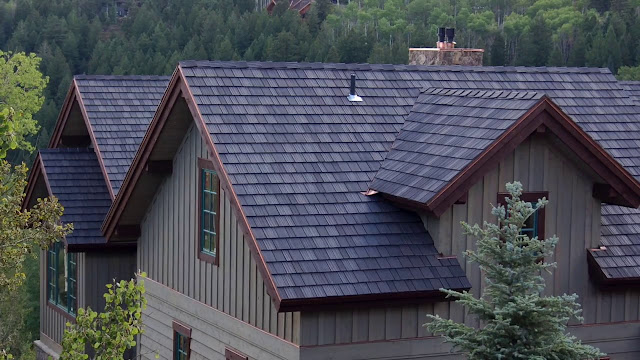Roof shingles are almost always highly visible and so are an important aspect of a building's aesthetics in patterns, textures and colors. Roof shingles, like other building materials on vernacular buildings, are typically of a material locally available.
>> Related Post: Solar Roof Maintenance that you need to know.
The type of shingle is taken into account before construction because the material affects the roof pitch and construction method: Some shingles can be installed on lath where others need solid sheathing (sheeting) on the roof deck.
All shingle roofs are installed from the bottom upward beginning with a starter course and the edge seams offset to avoid leaks. Many shingle installations benefit from being placed on top of an underlayment material such as asphalt felt paper to prevent leaks even from wind driven rain and snow and ice dams in cold climates.
At the ridge the shingles on one side of the roof simply extend past the ridge or there is a ridge cap consisting of boards, copper, or lead sheeting.
1. Fiberglass Shingles
Before, asphalt was made from organic materials and fiberglass.
But due to the problems organic shingles are taking through the years, especially from rot and water damage, fiberglass shingles are then preferred to be used to combat these organic shingle problems.
Fiberglass shingles have the same content as asphalt shingles but it greatly differs from the materials of the matting.
The matting uses fiberglass, wherein strands are woven together to create better durability and strength compared to using organic materials.
And because it is made from fiber, the color lasts longer, has fewer chances of rot growth, and is water-resistant compared to asphalt organic shingles.
>> Related Post: Best practices for roofing inspections.
2. Stone Shingle
Slate shingles are also called slate tiles, the usual name outside the US. Slate roof shingles are relatively expensive to install but can last 80 to 400 years depending on the quality of the slate used, and how well they are maintained. The material itself deteriorates only slowly, and may be recycled from one building to another.
The primary means of failure in a slate roof is when individual slates lose their peg attachment and begin to slide out of place. This can open up small gaps above each slate. A secondary mode of failure is when the slates themselves begin to break up.
The lower parts of a slate may break loose, giving a gap below a slate. Commonly the small and stressed area above the nail hole may fail, allowing the slate to slip as before. In the worst cases, a slate may simply break in half and be lost altogether.
A common repair to slate roofs is to apply 'torching', a mortar fillet underneath the slates, attaching them to the battens. This may apply as either a repair, to hold slipping slates, or pre-emptively on construction.
Where slates are particularly heavy, the roof may begin to split apart along the roofline. This usually follows rot developing and weakening the internal timbers, often as a result of poor ventilation within the roof space.
>> Related Post: What Style Of Asphalt Shingles Are Right For You?
An important aspect to slate roofs is the use of a metal flashing which will last as long as the slates. Slate shingles may be cut in a variety of decorative patterns and are available in several colors.
Flagstone shingles are a traditional roofing material. Some stone shingles are fastened in place but some simply are held by gravity, so the roof pitch cannot be too steep or the stones will slide off the roof. Sandstone has also been used to make shingles.
Conclusion
Swadley Roof Systems offers the best roofing services in the Houston, Austin, San Antonio and Dallas area.
- Tel: 832-559-8463
- Email: info@swadleyroofsystems.com
- Location: 17413 FM 2920 Suite O Tomball, TX 77377
- Facebook: Fanpage Swadley Roof Systems
- Website: https://www.swadleyroofsystems.com/







0 Comments
Đăng nhận xét